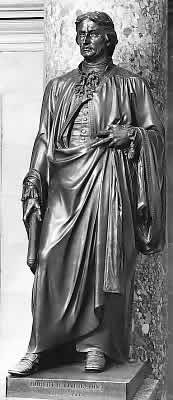Statue of Robert R. Livingston facts for kids
Quick facts for kids Robert R. Livingston |
|
|---|---|
 |
|
| Artist | Erastus Dow Palmer |
| Medium | Bronze sculpture |
| Subject | Robert R. Livingston |
| Location | Washington, D.C., U.S. |
The Robert R. Livingston statue is a cool bronze sculpture made in 1875. It shows Robert R. Livingston, who was one of the important Founding Fathers of the United States. A famous artist named Erastus Dow Palmer from New York created it. You can find this statue in the United States Capitol building in Washington, D.C.. It's part of a special collection called the National Statuary Hall Collection. This statue is one of two gifts from the state of New York to this collection.
The Story of the Robert R. Livingston Statue
How It Was Made
In 1873, the artist Erastus Dow Palmer got the job to make the Livingston statue. He decided to move to Paris in France to work on it. This was a bit different because many American artists at that time usually went to Rome in Italy. In Paris, Palmer worked on shaping the statue and then casting it in bronze. After he finished, he brought the statue and himself back to the United States.
A historian named Wayne Craven compared this statue to others in the collection. He said that even though the Livingston statue is a bit bigger than a real person, it looks small next to some of the giant marble and bronze statues. However, he also noted that few other statues are as well-made.
Where to Find the Statues
While in Paris, Palmer made two copies of the statue. One copy was sent to the United States Capitol in Washington, D.C. The other copy went to the New York Court of Appeals building in Albany. There is also a plaster version of the statue at Livingston Hall, located at the State University of New York at Albany.
One of these statues was shown at a big event called the Centennial International Exhibition in Philadelphia in 1876. It even won a top award! Since the statue in Washington was already put in place in 1875, it's likely that the statue sent to Albany or the plaster version was the one shown at the exhibition in Philadelphia.

